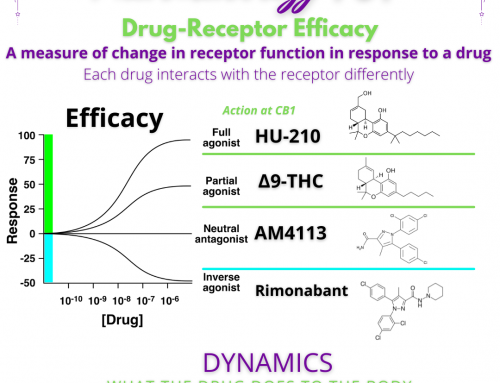Just when you think you’ve figured out all of the complex ways that cannabis works in the body, scientists come up with new additions.
The classic endocannabinoid system (ECS) is composed of CB1, CB2, anandamide, and 2-AG. But certain channels, known as transient receptor potential (TRP) ion channels, interact with cannabinoids, cannabis terpenes, or molecules in the body, to produce effects and influence sensations. The TRP channels are a diverse set of channels, some of which are part of a larger ECS, dubbed the endocannabinoidome (eCBome), a complex, master regulatory system.2
English, Please
TRP channels can be found broadly in nature, occurring in humans, rodents, worms, zebrafish and more.3 These channels perform many functions, most of which are for environment sensing. For example, these receptors are at least partially responsible for the body’s ability to sense and feel temperature changes. TRP channels help our bodies sense and respond to light, sound, touch, taste and chemical exposure.3 They are widely spread at a cellular level throughout the living world to help life rapidly respond to the environment during a dynamic life on earth.
TRP channels are densely distributed throughout much of the body, both inside and out. This superfamily of TRP channels is composed of 28 similar-but-unique channels.2 They work by moving cations like calcium (Ca2+) in and out of cells in response to stimuli. TRP channels are the reason for the numbing or burning sensation commonly caused by plant essential oils. These channels can also engage with phytocannabinoids and endocannabinoids.
Feeling the Heat – and the Chill
The most notorious TRP channel activator is best known for its ability to cause a powerful burning sensation. This vanilloid type-I TRP channel (TRPV1) activator is known medically as capsaicin and more commonly as hot chili oil. When hot chili oil touches the skin or mouth, the area does not become hot even though it feels as if it’s on fire. In actuality, the sensation of heat is caused by the interaction of capsaicin at the TRPV1 receptor.2 This interaction can be quite intense and is not just limited to your skin or mouth. These TRP channels are located throughout the gut, which is why hot foods can irritate the GI tract going in…and going out.4
TRP channels are widely spread in nature and so are terpenoids (terpene-like plant molecules). Many of these plant terpenoids naturally engage with numerous TRP channels. Myrcene, a commonly occurring terpene in cannabis, activates the TRPV1 channel. Another common example of a TRP activator is menthol, a terpene-alcohol that occurs naturally in mint. Menthol interacts with the cold-sensing channel known as TRP melastatin type-8 (TRPM8).2 This channel is the reason why applying menthol (i.e. peppermint oil) to your skin can produce the feeling of coolness.
Some experts believe that irritating sensations caused by smoking menthol cigarettes are blunted by TRPM8 activation, making menthol cigarettes easier to inhale and therefore more addicting.6 Interestingly, phytocannabinoids like THC and endocannabinoids like anandamide block TRPM8.
Cannabinoids and TRP Channels
It’s not just plant molecules that interact with the TRPs channels. The well-known endocannabinoids, anandamide and 2-AG have also been found to interact with numerous TRP channels. Phytocannabinoids like THC can also activate and/or block certain TRP channels, potentially contributing to their medical effects.2 As we continue to uncover more about this complex lipid signaling system, the challenge will be identifying how to best apply our knowledge clinically to help patients and users.
There is much speculation about the TRP channels’ importance when it comes to cannabinoid therapeutics. These channels could be associated with numerous types of disease and their function could give us clues as to why cannabis works therapeutically for some, but not others.3 TRP channels could also help explain why certain cannabis varieties may benefit a person more than another cannabis variety with the same cannabinoid profile.
Some experts believe that it is actually TRP dysregulation that leads to a rare cannabis-induced vomiting disorder known as cannabinoid hyperemesis syndrome (CHS).7 It is common for patients with this condition to use hot baths to help relieve their nausea, and it is thought that the heat may activate the thermosensitive TRP receptors like TRPV1. When treating CHS patients, doctors may apply capsaicin cream to the patient’s abdomen or back, simulating the warmth of a bath and hopefully providing temporary relief from the profound nausea. Unfortunately, much of the science supporting this practice is not yet conclusive, but the mechanism makes sense because of how THC interacts with eCBome. Hot showers and capsaicin may not work for everyone, though, and the only agreed-upon treatment for CHS is cessation of cannabis use.
What It All Means Is Not Yet Clear
Despite a high level of complexity and a limited understanding of TRP channels, it is abundantly clear that whole plant cannabis is a complex medicine that acts on many targets within the body. We should all take a moment to appreciate the complexity of the plant, our bodies, and the living world around us.
1.) Veilleux A, Di Marzo V, Silvestri C. The Expanded Endocannabinoid System/Endocannabinoidome as a Potential Target for Treating Diabetes Mellitus. Curr Diab Rep. 2019;19(11):117. Published 2019 Nov 4. doi:10.1007/s11892-019-1248-9
2.) Muller C, Morales P, Reggio PH. Cannabinoid Ligands Targeting TRP Channels. Front Mol Neurosci. 2019;11:487. Published 2019 Jan 15. doi:10.3389/fnmol.2018.00487
3.) Venkatachalam K, Montell C. TRP channels. Annu Rev Biochem. 2007;76:387-417. doi:10.1146/annurev.biochem.75.103004.142819
4. ) Alaimo A, Rubert J. The Pivotal Role of TRP Channels in Homeostasis and Diseases throughout the Gastrointestinal Tract. Int J Mol Sci. 2019;20(21):5277. Published 2019 Oct 24. doi:10.3390/ijms20215277
5.) Jansen C, Shimoda LMN, Kawakami JK, et al. Myrcene and terpene regulation of TRPV1. Channels (Austin). 2019;13(1):344-366. doi:10.1080/19336950.2019.1654347
6.) Janero DR, Makriyannis A. Terpenes and lipids of the endocannabinoid and transient-receptor-potential-channel biosignaling systems. ACS Chem Neurosci. 2014;5(11):1097-1106. doi:10.1021/cn5000875
7.) Perisetti A, Goyal H. Endocannabinoid system and cannabis hyperemesis syndrome: a narrative update [published online ahead of print, 2020 Nov 17]. Eur J Gastroenterol Hepatol. 2020; doi:10.1097/MEG.0000000000001992



